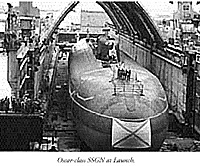 Disasters always take us by surprise. This one was waiting to happen, but when it did, it was a bad one, not as bad as it could get, since no radiation has been released, but still pretty bad. Its effects on the Russian Navy will go far beyond the tragic loss of life.
Disasters always take us by surprise. This one was waiting to happen, but when it did, it was a bad one, not as bad as it could get, since no radiation has been released, but still pretty bad. Its effects on the Russian Navy will go far beyond the tragic loss of life.
Oscar-class SSGN at Launch.
On Saturday, 12 August, the Project 949A (Antey) class submarine Kursk was taking part in exercises in the Barents Sea. As part of the exercise, she was preparing to fire a weapon, possibly an advanced torpedo or a submerged-launch missile. Whatever the exact cause, something went horribly wrong, and she suffered an explosion forward. The explosion was powerful enough to be recorded by distant seismic sensors in Greenland and Finland, as well as one in Norway. We now know that as a result of that explosion, all 118 souls aboard were killed, probably almost immediately, and she sank to the bottom of the Barents Sea northeast of Murmansk.
The first indication of the loss was Kursk's failure to make radio contact at 1800 12 August (Note: all times are Moscow time). The search for her started immediately. The next day, Sunday, at 0435, Pyotr Veliky (Kirov #4), the exercise flagship, located an "abnormality" in the sea bed that turned out to be the sunken submarine. The salvage tug Nikolay Chiker verified her identity with underwater television that evening, at about 1830 .
Starting Sunday morning (13 August), rescue vessels congregated at the spot and attempts to reach the sub and its trapped crew began. Admiral Vieceslav A. Popov, commander of the Northern Fleet and exercise commander on Pyotr Veliky, was designated as the rescue commander.
For over a week the world watched and listened and tried to make sense of the many contradictory reports. At first, they were reassuring and hopeful. The crew was receiving air and power from the surface, and they might even be able to fix the problem themselves. Then the news became worse, and then worse still, until Norwegian divers confirmed the death of all aboard.
Who was Kursk?
The twelfth Oscar-class hull built, and the tenth Oscar II, Kursk (K-141) was laid down in 1992, launched in 1994 and commissioned on 20 January 1995, making him one of the newest boats in the Northern Fleet, or indeed, in the Russian Navy. Shortly before the exercise, her crew won an award as the best submarine in the Northern Fleet.
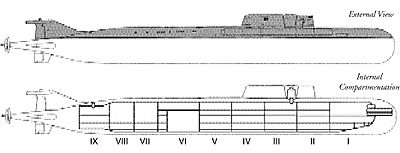 She was assigned to the 7th SSGN division of the 1st Submarine Flotilla of the Northern Fleet. Her home port was Vidiayevo in Uraguba bay. Her status as a "showboat" was indicated by her late 1999 deployment to the Mediterranean. Only the best units are picked for these tasks. Of double-hull construction, she had nine watertight compartments: I -Torpedo, II - Control Room, III -Sonar, Missile Control and Radio Room, IV - Quarters, V and V-bis -different stations, VI - reactor, VII and VIII - turbines, IX - electric motors.
She was assigned to the 7th SSGN division of the 1st Submarine Flotilla of the Northern Fleet. Her home port was Vidiayevo in Uraguba bay. Her status as a "showboat" was indicated by her late 1999 deployment to the Mediterranean. Only the best units are picked for these tasks. Of double-hull construction, she had nine watertight compartments: I -Torpedo, II - Control Room, III -Sonar, Missile Control and Radio Room, IV - Quarters, V and V-bis -different stations, VI - reactor, VII and VIII - turbines, IX - electric motors.
What was she doing?
At the time of her loss, Kursk was part of a large exercise, involving as many as thirty units. It was the largest exercise conducted since the fall of the Soviet Union, and was certainly an important step in the rebulding of the new Russian Navy's image and capability as a effective navy. She had already fired a P-700 Granit [SS-N-19 Shipwreck] antiship missile, which reportedly hit a target hulk 200 nm downrange.
![]()
Depending on the source, the next event was to be the firing of either a Veter [SS-N-16 Stallion], or a "torpedo salvo." That torpedo or torpedoes, could have been the Shkval, a rocket-powered weapon, or a new UGST torpedo with a monopropellant similar to the US Navy's Otto fuel.
The last radio contact with the sub was sometime that morning, with Pyotr Veliky, when she gave Kursk permission to fire a "training weapon." The next expected radio contact was at 1800, which was never received.
When she left port on the morning of 10 August, under the command of Captain First Rank Gennady P. Liachin, she not only carried her complement of 107 men, but five officers of the 7th Submarine Division staff, including the Chief of Staff, and two representatives of the Dagdizel plant of the Dvigatel manufacturing bureau, a total of 118 souls.
Russian behavior during the incident
Old reflexes die slowly. Confronted with a crisis, the Russians went back to their old ways. They told lies, ones that could be easily detected. They told conflicting stories. They withheld information that was needed by the Norwegian divers. In fact, the divers have said that they were deliberately provided with incorrect data.
This was not part of a deliberate plan. In fact, it was the absence of a plan for dealing with a disaster this public, that resulted in a public relations disaster as well. Dealing with the press is just not something a Russian officer thinks about. US or Western officers may not like press attention, but they know they have to deal with it. Russians are not as accountable.
Putin's refusal to ask for foreign help has opened him up to criticism, both from at home and abroad. Russian pride runs deep, and just as deep runs an inferiority complex about the quality of their technology. This has only been exacerbated by their present poverty. It was probably an unspoken axiom that "foreigners" could easily rescue Kursk's crew. Putin and the navy wanted to show the world they could do it themselves.
Putin is also inexperienced at dealing with a public disaster, and while some parts of the Russian military have used the media effectively, others see them only as a threat. Nobody in the Russian government or military has ever been punished for lying to the media.
If they'd been more open, it wouldn't have saved the crew, but it wouldn't have cost them anything either.
What about Russian claim of collision?
The Russians claim that Kursk collided with another vessel, probably a "foreign submarine," a transparent attempt to shift blame for the disaster. The government has gone so far as to launch a criminal probe to find the ship that left the scene of the collision. Other causes suggested by the Russians were a collision with the seabed (difficult since she was at slow speed near the surface) or a collision with a WW II mine (did the Germans make any that big?).
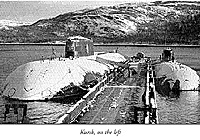 Kursk, on the left.
Kursk, on the left.
Russian officialdom seems to have settled on the collision as its explanation. Is it at all possible? At 19,400 tons submerged, Kursk displaces a little more than an American Trident boat, and is more than twice the size of any Western nuclear attack boat. If she collided with a submarine hard enough to suffer that much damage herself, the shattered wreckage of the other one should be lying there on the bottom next to her.
Similarly, any surface ship she collided with that was able to sink Kursk would have suffered serious, probably fatal underwater hull damage.
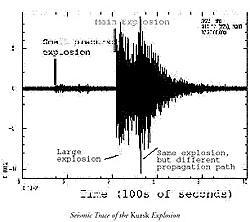 And by the way, how hard do ships have to collide to register as a seismic event? Scientists who have examined the seismic traces say they are too strong for any collision, and are consistent not only in strength, but in signal type with an explosion.
And by the way, how hard do ships have to collide to register as a seismic event? Scientists who have examined the seismic traces say they are too strong for any collision, and are consistent not only in strength, but in signal type with an explosion.
Why would the Russians make up such a patently false claim? Because there's nobody to demand a better one.
How did it happen, exactly?
We know Kursk was preparing to launch. Divers found her periscope extended, which means she was near the surface. Somehow, probably through a combination of mechanical faults and human errors, the motor of an SS-N-16 being prepared for launch ignited.
If you examine the seismic trace, it shows an initial detonation, but the vibration/disturbance continues, almost at the same rate. I submit that's a rocket motor burning. For whatever reason, a small detonation (if there can be such a thing) occurred after the weapon was loaded in the torpedo tube. That explosion damaged the motor, or it was damaged already (past shelf life?), and started a violent fire in the confined space of the torpedo tube. While a rocket motor can burn out in a few seconds when operating normally, if the motor is broken or cracked, combustion is much less efficient, although still violent.
We believe the weapon was in the tube, and not just in the spave, because the damage was confined to one side of the vessel.
Russian missiles are cold-launched, then ignite after they are clear of the ship. The tube door wasn't built for that, and could not have withstood the heat for very long.
A personal aside: From 1978 to 1980 I was ASW officer on USS McKean (DD-784). Yes, that's how old I am. That made me responsible for the ASROC launcher, a box launcher amidships that could hold up to eight ASROCs, a standoff weapon weapon like the Veter, but with a much shorter range and a smaller motor. Remember the word "smaller."
One of the special drills we trained for was "Fire in the ASROC launcher!" Each ASROC could produce 15,000 pounds of thrust, sufficient to propel a Mk46 torpedo five miles. As part of the drill, the first man on the scene of an ASROC fire was supposed to run to the front on the launcher, open a small door, and pull a handle. This manual control allowed him to train the launcher so it faced outboard instead of fore and aft. That way, if the motor was ignited by the fire, it wouldn't melt the aft superstructure.
The Veter has a range of 60 nm and a larger payload. It's easy to imagine the men in the compartment trying to fight the fire. If it was confined to the tube, there is little they can do beyond opening the doors, and the controls for that were probably damaged in the first explosion.
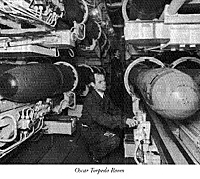 Oscar Torpedo Room
Oscar Torpedo Room
If it started outside the tube, in the space, or burned through the tube door, then the torpedo room was immediately filled with searingly hot, poisonous gases. No firefighting equipment aboard ship, whether water or foam, could have extinguished the fire.
The second detonation probably represents the flame finally reaching the bulk of the rocket's propellant, and in its damaged state, triggering a massive explosion.
Reports say the second detonation, which measured 3.47 on the Richter scale, was equivalent to somewhere between one and two tons of TNT equivalent. The shock of the explosion broke open the pressure hull in at least the first three compartments, the second compartment being the control room.
At this point the submarine is in mortal danger. Although a Russian submarine can still surface with one compartment flooded, it can't with two.
The Oscar II has nine separate watertight compartments. (A Los Angeles class has three, and that's because of the reactor bulkheads.) But the shock of the explosion did still more damage. The Oscar II is one of the toughest submarines in the world. But subs are designed to withstand damage from attacks from the outside. If a torpedo or mine strikes a sub's hull, at least half the blast is lost, vented away from the hull. In this case, the blast was not only contained within the hull. It was probably in the tube, so the force of the blast was transmitted directly to the pressure hull and the rest of the sub's structure. Nobody's ever calculated the effect of that on a submarine's structure, but the effects would have been devastating.
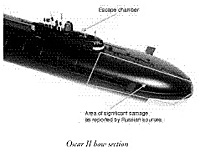 Oscar II bow section (Chris Carlson)
Oscar II bow section (Chris Carlson)
Traveling the length of the boat, it broke welds and fittings throughout the interior, possibly causing enough damage to flood every compartment.
The shock probably also caused fires and injured or killed many of the men aboard. By now, Kursk was undoubtely descending, her forward planes out of control, her forward compartments flooded, and her forward ballast tanks open to the sea.
Kursk was probably moving slowly at the time of the accident. Steerageway would have been two or three knots, and she didn't want or need to move faster than ten knots, especially with her scope up. She would have accelerated from that speed as she approached the bottom, 75-80 meters below her keel. Underwater photos indicate that she did strike at some speed, because she left a trench as she struck the bottom.
The impact of the 19,400-ton sub striking the sea bed would have finished the job started by the explosion. With the watertight integrity of every compartment lost, the boat would have completely flooded in hours.
The State of the Russian Navy
This was an accident waiting to happen. The poor material condition of the Russian Navy since the collapse of the Soviet Union has been the stuff of legend -- or nightmare. Poorly trained, poorly paid, even poorly fed sailors are led by officers who are no better off then their men. Their navy cannot operate. Sometimes the navy can't even pay its electric bill.
And a nuclear sub is the most complex, expensive, and disaster-prone kind of a warship there is. The Soviet navy had its share of nuclear sub incidents even when properly funded. It was plain bad luck that it had to happen to one of the best, and in a very public way.
Unanswered Questions
This analysis represents a synthesis of many reports, "taking a vote" and combining the most probable outcomes. But an accident can be the most improbable thing in the world, and this one happened at the bottom of the water off the coast of a country where they don't like to share their problems.
What weapon was actually being fired? The Russians can tell us, but they haven't. Since it was a "training weapon," we can rule out any experimental weapon like a monopropellant-fueled torpedo. AA warhead detonation is also unlikely since training rounds have inert warheads.
What did the US and British subs hear? Most accounts state that there were two US boats and one British sub in the area. One of the US boats has been identified as USS Memphis. The Russian press has said the other was USS Toledo. Their exact positions have not been revealed, but based on books like Blind Man's Bluff we can assume that they were in the areas to observe the exercise. They were probably close. USNS Loyal, a SURTASS ship, was also in a position to hear the explosion.
Apparently, the US has offered to share what it's learned with the Russians. Hopefully they'll share it with the public as well.
Aftermath
Politically, the Russians have suffered a military disaster of the highest order. Not only did they lose a scarce fleet unit worth millions of rubles, one of a dwindling number of operational vessels. The Russian navy is a symbol of their national strength, and the nuclear navy a symbol of that strength continuing even as the rest of the fleet rotted.
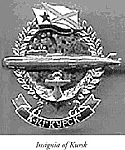 Insignia of Kursk
Insignia of Kursk
In 1998, the Russians celebrated the 300th Anniversary of the navy, commissioning Pyotr Veliky and several smaller vessels. It marked the beginning of a deliberate attempt to rebuild the navy, both materially and morally. This exercise, if successful, would have been trumpeted as proof of a resurgent fleet, still capable and dangerous. Instead, it marked a public failure.
Russian credibility, never a strong point, has been further damaged by their inept handling of the affair. An unwillingness to provide vital information to the Norwegians, who were there to help, has renewed the international image of the Russians as paranoid and untrusting.
Putin has already reacted to the disaster, announcing a cutback of 350,000 armed forces personnel. This represents almost a third of their total strength. Of course, this was necessary, since the defense budget couldn't support a military of that size anyway. But what kind of military can the budget support? It's effectively a regional navy now. The Russian fleet could be reduced to a coastal force.
Don't look for an official report of the investigation to be published any time soon. 86R Veter [SS-N-16 Stallion]
More Kursk
BT
Back to The Naval Sitrep #19 Table of Contents
Back to Naval Sitrep List of Issues
Back to MagWeb Master Magazine List
© Copyright 2000 by Larry Bond and Clash of Arms.
This article appears in MagWeb (Magazine Web) on the Internet World Wide Web.
Other military history articles and gaming articles are available at http://www.magweb.com